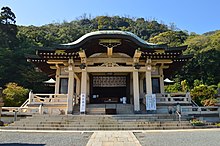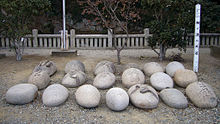You can help expand this article with text translated from the corresponding article in Japanese. (January 2024) Click [show] for important translation instructions.
|
| Nunakuma Shrine | |
|---|---|
 Honden | |
| Religion | |
| Affiliation | Shinto |
| Deity | Watatsumi, Susanoo (Gozu Tenno) |

Nunakuma Shrine (沼名前神社) is a Shinto shrine located in Fukuyama City, Hiroshima Prefecture Japan. It is a Gion shrine.[1] It is a Beppyo shrine, or a shrine that is particularly notable in a certain way with a significant history to it.[2] It is located in Fukuyama, Hiroshima.
It has two component shrines Watasu Shrine (渡守神社, Watasu Jinja) and Tomo Gion Shrine (鞆祇園宮, Tomo Gion-gu)[3] which were merged together due to the Shrine Consolidation Policy.

It has a famous stone gate and Noh stage that were donated by the Mizuno family retainers of the Fukuyama Domain.[4][1]
Enshrined deities
[edit]Two deities are enshrined at the shrine.
- Main enshrined deity
-
- Owatatsumi no Mikoto - The enshrined deity of the old Watasu Shrine.[5]: 124
- Secondary enshrined deity
-
- Susanoo-no-Mikoto - see Gion worship for more info[5]: 124
History
[edit]The shrine is ancient. It was originally two shrines, and both are mentioned in the Engishiki Jinmyocho written in 927.[5]: 124 Its area was very strategically important on the Seto Inland Sea.[5]: 124
In 1711 a Korean emissary said it was the most beautiful place in Japan, even more than Itsukushima Shrine.[5]: 124
In the Meiji era, Watasu Shrine (渡守神社, Watasu Jinja) and Tomo Gion Shrine (鞆祇園宮, Tomo Gion-gu) were combined and renamed as Nunakuma Shrine according to the Engishiki Jinmyocho. according to the Shrine Consolidation Policy. The shrine continues to enshrine two deities, Owatatsumi-no-Mikoto and Susanoo-no-Mikoto, who were originally enshrined separately by each shrine.[6]
Watasu Shrine
[edit]According to legend Watasu shrine was established in the second year of Emperor Chuai's reign.[6] Empress Jingu headed to western Japan and enshrined Watatsumi-no-mikoto on a local sacred stone, praying for safe sea routes after her failed invasion of Korea. On her way back, she reportedly said to Watatsumi no Mikoto, "Takatomo Izuno." The name "Tomo" is said to have originated from the fact that "tomo" was one of the tools used for bows.[6][5]: 124 Tomo is a wrist protector used when firing arrows.[5]: 124 She gave hers to the shrine as a gift to thank Watatsumi for her safe return from Korea.[5]: 124
There are 22 Watatsumi shrines in the region that claim to have been founded by her after her return from Korea.[7]: 7 Most notably Watatsumi Shrine in Kobe.[7]: 7 [8][7]: 7
In the Engishiki Jinmyocho, published in 927,[9] there is a description of a Shikinaisha called 'Numakuma-jinja Shrine' located in Numakuma District, Bingo Province.[6][5]: 124
In modern times, Watasu Shrine is said to enshrine Sarutahiko-no-kami and Funatama-no-mikoto. The shrine was originally located in Gojihira Village or Tomonoseki-cho and was moved to its current location during the Keicho era (1596-1615) as a precinct shrine of Gion Shrine. In the Meireki era (1655-1658), the main shrine was rebuilt by the feudal lord Katsutada Mizuno.
It has a three day long festival on august 11th of the lunar calendar.[10]
Tomo Gion Shrine
[edit]The origins of this subshrine are less clear, but it was extant at the time of 927 when the Engishiki Jinmyocho was written.[5]: 124
It is a Gion Shrine[6] Gion shrines originally worshipped Gozu Tenno, a Buddhist influenced Onmyōdō deity[11][12][13] that was later syncretized with Susanoo-no-Mikoto.[13]
According to the Engishiki Jinmyocho, this shrine is the shrine is the source by which Gozu Tenno entered Yasaka Shrine through Kanjo, this makes it highly significant to the history of the Gion cult.[5]: 124
The shrine is commonly referred to as 'Gion-san' by locals.[1]
Its torii are listed as Important Cultural Property of Hiroshima prefecture.[1]
See also
[edit]References
[edit]- ^ a b c d fukuyama_tomonoura (2020-01-28). ""Nunakuma Shrine" a little Gion protecting the town and the sea of Tomonoura | VISIT鞆の浦". Retrieved 2023-12-02.
- ^ "別表神社とは?御朱印めぐりに参考になる「別表神社一覧」とマップ | 開運戦隊ゴシュインジャー". jinja-gosyuin.com. Retrieved 2023-04-02.
- ^ a-tsukamoto (2021-02-24). "Shrine ritual of the Bow | VISIT鞆の浦". Retrieved 2023-12-07.
- ^ "Nunakuma Shrine(Hiroshima)". Nationwide location database. Retrieved 2023-12-07.
- ^ a b c d e f g h i j k Faure, Bernard (2021-01-01). "GODS OF MEDIEVAL JAPAN - Vol. 3". Rage and Ravage.
- ^ a b c d e https://tomo-gionsan.com/english.pdf
- ^ a b c "The Romance of Kobe". www.forgottenbooks.com. Retrieved 2023-11-24.
- ^ "Watatsumi Shrine | 海神社 |Hyogo-ken, Kobe-shi". shintoshrines. Retrieved 2023-04-06.
- ^ Nussbaum, Louis-Frédéric. (2005). "Engi-shiki" in Japan Encyclopedia, p. 178.
- ^ "【Tomonoura Events】 - TOMO-MONOGATARI". tomomonogatari.com. Retrieved 2023-12-07.
- ^ Lillehoj, Elizabeth (2004-01-01). Critical Perspectives on Classicism in Japanese Painting: 1600 - 1700. University of Hawaii Press. ISBN 978-0-8248-2699-4.
- ^ "Japan Shinto Kami Gods | Gozu-Tennō 牛頭天王| Rods Shinto". shintoshrines. Retrieved 2022-01-10.
- ^ a b McMullin, Neil (1988-02-01). "On Placating the Gods and Pacifying the Populace: The Case of the Gion "Goryō" Cult". History of Religions. 27 (3): 270–293. doi:10.1086/463123. ISSN 0018-2710. S2CID 162357693.

